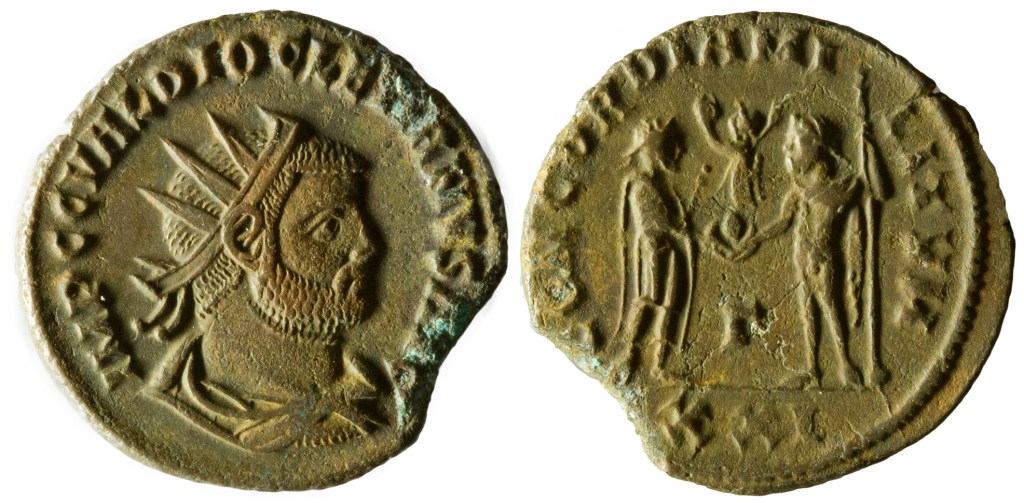February 24, 2016, by Will Leveritt
On this day in AD 303 the so-called “Great Persecution” of Christians within the Roman Empire began
Text by Michael Wuk
If the ancient sources can be believed, the followers of Christ suffered greatly from the end of the second century AD onwards, when prominent ecclesiastical scholars such as Tertullian began to propagate their interpretations of scripture and argue against participation in imperial pagan ceremonies, resulting in some Christians being forced out of certain social, political and military institutions.

AE AE Follis of Diocletian. Obverse has radiate, draped bust of the emperor right, IMP CC VAL DIOCLETIANVS PF AVG. Reverse has Emperor facing right receiving Victory from Jupiter facing left holding a sceptre, CONCORDIA MILITVM / GAMMA / XXI. 20mm, 3.59g, 12 o’clock. RIC V 284v, G. Numismatic information by Rob Stone and Olivia Webster.
Various emperors preceding Diocletian reportedly worked against Christianity. Cyprian describes the edict of Decius (AD 249-51) which mandated the performance of supplicationes – in which all citizens were ordered to offer a sacrifice for the emperor – across the Empire; individuals would then receive a libellum, a certificate declaring their participation. Both Eusebius and Cyprian further claim that Valerian (AD 253-60) pushed many Christians to martyrdom or apostasy (renouncing their faith), which they believed to be no real choice.
However, the Diocletianic persecution was viewed by Christians as the culmination of all previous attempts to purge them from society, a dreadful pogrom that would not end for eight years.
The first edict of the Diocletianic persecution was promulgated on 24 February AD 303, the day following the Terminalia, a festival in honour of the god of boundaries, Terminus. The symbolism was clear: this would be the beginning of Christianity’s termination.
This legislation targeted senior clerics and church property, as well as ordering the destruction of scripture and places of worship. Judicial torture was threatened, and legal rights were removed from those who professed themselves Christian.
According to the Christian authors of the time, no one was safe either from martyrdom, which Eusebius claimed to be the correct response, or apostasy. Three further edicts were declared in subsequent years, culminating in AD 304 with the fourth edict, which demanded a ritual offering be made, in public, on pain of death.
In May 305, Diocletian and his co-emperor Maximian resigned and went into retirement, to be replaced by their junior partners, as per the terms of the tetrarchic political system Diocletian had instituted in the 290s.
Galerius took over control of the eastern half of the Empire and continued the persecution until AD 311 when he issued an edict of toleration, allowing believers to practice their faith in safety.
Diocletian’s tetrarchic system began to collapse soon after his abdication, and by 313 two men were in ultimate control of the Empire: Constantine the Great and Licinius. By this point Constantine was himself a Christian and together they issued the Edict of Milan, which proclaimed an Empire-wide acceptance of Christians and their faith, and marked an end to the persecutions.
From this point onwards, and especially as sole emperor from 324 onwards, Constantine would do much to expand and entrench the role of Christianity in the Empire.
No comments yet, fill out a comment to be the first

Leave a Reply